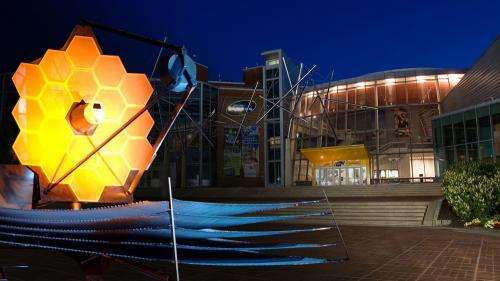Credit: NASA, ESA, and P. Jeffries (STScI)
(PhysOrg.com) -- Baltimore's Maryland Science Center is going to be the "landing site" for the full-scale model of NASA's James Webb Space Telescope, and it's free for all to see.
The Webb telescope life-sized model is as big as a tennis court, and it's coming to the Maryland Science Center at Baltimore's Inner Harbor from October 14 through 26, 2011. It's a chance for young and old to get a close-up look at the successor to the Hubble Space Telescope in the same size it will be launched into space.
The real James Webb Space Telescope is currently being built, but this model will be constructed in a couple of days. The real Webb will be the largest space telescope ever built. Once in orbit, the Webb telescope will look back in time more than 13 billion years to help us understand the formation of galaxies, stars, and planets.
Experts will be on hand to discuss the Webb telescope's deep-space mission, how it will observe distant galaxies and nearby stars and planets, and the progress made to date in building the observatory. Spokespeople will also be available starting at 10 a.m. EDT and throughout the model exhibition. There will also be educational activities and an "Ask the Scientist" booth in front of the model during the daytime.
The Maryland Science Center is located at 601 Light Street, Baltimore, Md. 21230. For directions and more information, call the center at 410-685-5225.
The full-scale model of the Webb telescope was built by NASA's prime contractor to provide a better understanding of the size, scale, and complexity of the observatory. The model is constructed mainly of aluminum and steel, weighs 12,000 pounds, and is approximately 80 feet long, 40 feet wide, and 40 feet tall. The model requires two trucks to ship it, and assembly takes a crew of 12 approximately four days.
The Webb telescope will add to observations by earlier space telescopes, and stretch the frontiers of science with its discoveries. The model's size shows the telescope's complexity and how the observatory will enable the Webb telescope's unique mission.
Provided by JPL/NASA























